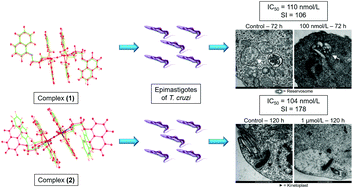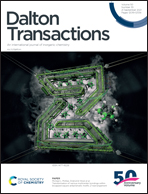Development of new dinuclear Fe(iii) coordination compounds with in vitro nanomolar antitrypanosomal activity†
Abstract
Chagas disease is a neglected tropical disease caused by the protozoan pathogen Trypanosoma cruzi. The disease is a major public health problem affecting about 6 to 7 million people worldwide, mostly in Latin America. The available therapy for this disease is based on two drugs, nifurtimox and benznidazole, which exhibit severe side effects, including resistance, severe cytotoxicity, variable efficacy and inefficiency in the chronic phase. Therefore, new drugs are urgently needed. Coordination compounds may be an interesting alternative for antiparasite therapy against Leishmania spp., Toxoplasma gondii and T. cruzi. Herein, we tested the in vitro effect on T. cruzi epimastigotes (Y strain) of two new μ-oxo Fe(III) dinuclear complexes: [(HL1)(Cl)Fe(μ-O)Fe(Cl)(HL2)](Cl)2·(CH3CH2OH)2·H2O (1) and [(HL2)(Cl)Fe(μ-O)Fe(Cl)(HL2)](Cl)2·H2O (2) where HL1 and HL2 are ligands which contain two pyridines, amine and alcohol moieties with a naphthyl pendant unit yielding a N3O coordination environment. Complexes (1) and (2), which are isomers, were completely characterized, including X-ray diffraction studies for complex (1). Parasites were treated with the complexes and the outcome was analyzed. Complex (1) exhibited the lowest IC50 values, which were 99 ± 3, 97 ± 2 and 110 ± 39 nM, after 48, 72 and 120 h of treatment, respectively. Complex (2) showed IC50 values of 118 ± 5, 122 ± 6 and 104 ± 29 nM for the same treatment times. Low cytotoxicity to the host cell LLC-MK2 was found for both complexes, resulting in impressive selectivity indexes of 106 for complex (1) and 178 for (2), after 120 h of treatment. Treatment with both complexes reduced the mitochondrial membrane potential of the parasite. Ultrastructural analysis of the parasite after treatment with complexes showed that the mitochondria outer membrane presented swelling and abnormal disposition around the kinetoplast; in addition, reservosomes presented anomalous spicules and rupture. The complexes showed low nanomolar IC50 values affecting mitochondria and reservosomes, essential organelles for the survival of the parasite. The low IC50 and the high selectivity index show that both complexes act as a new prototype of drugs against T. cruzi and may be used for further development in drug discovery to treat Chagas disease.



 Please wait while we load your content...
Please wait while we load your content...